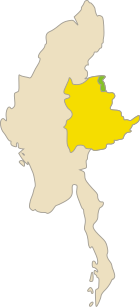Kokang
Kokang (also called Special Region 1 ) is an autonomous region in eastern Shan State in Burma . It was formed after the collapse of the Burmese Communist Party (KPB) in 1989. Its population is estimated at 150,000.
Together with the neighboring Special Zone 2, also known as the Wa state , Kokang was an important opium- growing area. Kokang was officially declared an opium-free region in 2003.
geography
The Saluen River forms the western border of Kokang. In the east, Kokang borders on the Chinese province of Yunnan . Kokang is 2700 km². The capital is Lao Kai (Chinese: 老街; Pinyin: Lǎojiē).
history
Kokang was the only Chinese state in what is now Burma. Yang Shien Tsai established a territory called Shin Da Hu in 1739. He and his family immigrated from China to what is now Burma. With military support, the family freed the Kokang area from bandits and offered protection to the local population. She later expanded her territory through a clever marriage policy and wars against the local Shan.
Yang Shien Tsai's son Yang Wei Shin assumed power in 1758 and increased the territory of Kokang tenfold. He renamed the territory Kho Kan Shan. After his death in 1795, Yang Yon Gen took power and named the territory Kokang. In 1840, Yang Guo Hwa became ruler, Heng of Kunang. Yang Guo Zhen ruled from 1874 to 1916. He established diplomatic relations with the British colonial power, which had conquered northern Burma in the 3rd British-Burmese War in 1885 . In 1887 he placed Kokang under the protection of the British Crown. After he went blind in 1916, he passed power to his nephew Yang Chun Yon. In 1927, Sao Yang Wen Pin became ruler of Kokang. He ruled until 1949 and supported the British colonial power in World War II in the fight against the Japanese and the Burma Independence Army (BIA). Kokang was never occupied by Japanese troops and remained in the hands of the British colonial administration. In August 1947, Kokang was declared an independent Shan state by the British, mainly because of the aid provided by the residents of Kokang during the Second World War. In 1948 Kokang became part of the Shan State of the Union of Burma. Several members of the Yang family held high positions in the central government. In 1949, defeated Kuomintang Chinese troops fled to Kokang. It took four years before they could be disarmed and flown out.
Sao Yang Wen Pin's successor was his son Sao Edward Yang Kyein Tsai, who, like all other Shan princes, was forced to abdicate by the Burmese in 1959. Democratic structures were introduced in the Shan states, but they did not last long. After General Ne Win's military coup in 1962, the Kokang Revolutionary Force took up armed struggle against the military government. It received arms from the Communist Party of Burma (CPB), and Kokang residents fought with CPB forces.
In 1989 Kokang became autonomous after the residents of Kokang mutinied against the leadership of the CPB. The mutineers signed a truce with the Burmese military government.
In August 2009, Kokang broke into armed clashes between Myanmar government troops and the MNDAA ceasefire army (see below), as a result of which government troops took control of the area and up to 37,000 people fled the area across the border into China.
MNDAA
Kokang has its own defense force, the MNDAA Myanmar Nationalities Democratic Alliance Army , headquartered in Lao Kai. The strength of the MNDAA was estimated at 2,000 armed men under the leadership of Peng Jiasheng (彭家 声). Most of the gunmen fled to China after the attack by SPDC troops . A small group joined the BGF (Border Guard Forces Program) program of the Myanmar government on December 4, 2009 . The Union government's BGF program provides for the ceasefire groups to be converted into government-dependent militias.
The MNDAA tried to recapture Laukkai in February 2015.
swell
- ↑ Kokang, the Yang Dynasty [1]
- ↑ Kokang Brief History
- ↑ Foreign Office Myanmar Domestic Policy [2]
- ↑ In the end, the SPDC achieved its objective as the MNDAA, which struck a ceasefire agreement with the Burmese government in 1989, is no more. Most of their estimated 2,500 fighters fled to China and a small group joined the BGF on Dec 4 (Maxmilian Wechsler: No united army for us, rebels vow ( Memento of the original from January 21, 2016 in the Internet Archive ) Info: The archive link became automatic inserted and not yet checked. Please check the original and archive link according to the instructions and then remove this note. )
- ↑ Xinhua - Myanmar govt forces in pursuit of Kokang ethnic army
See also
Coordinates: 23 ° 41 ' N , 98 ° 45' E

